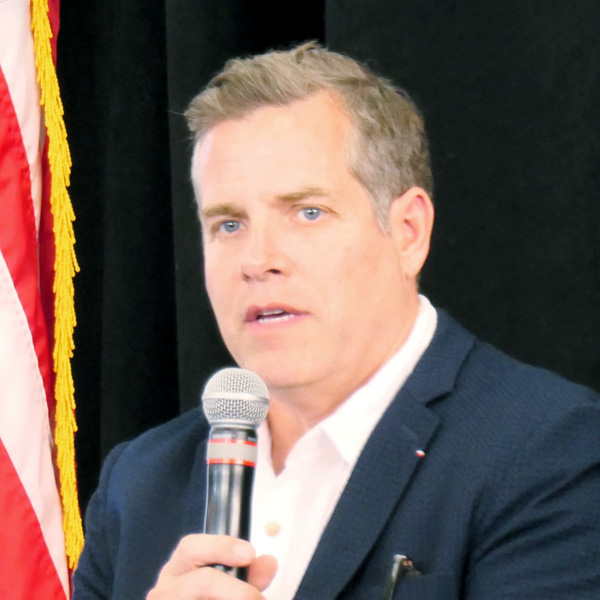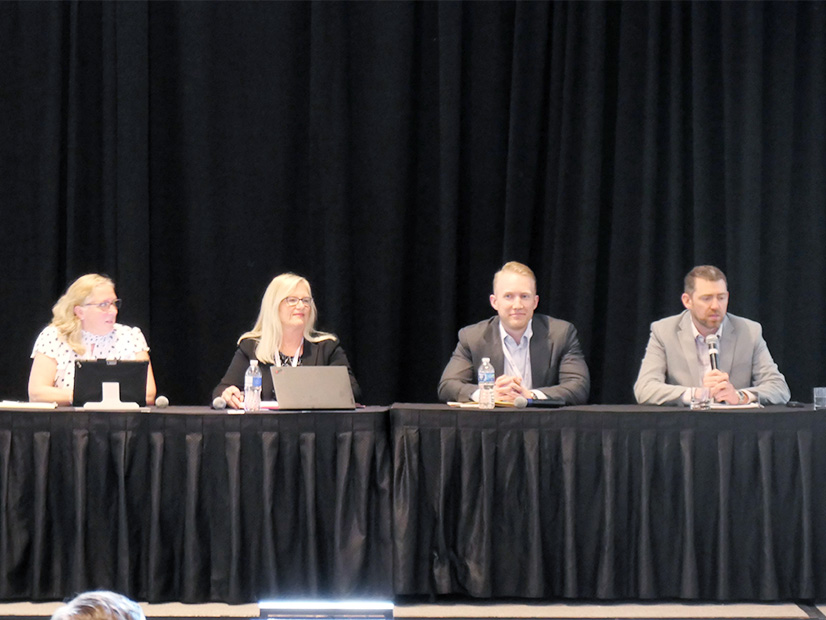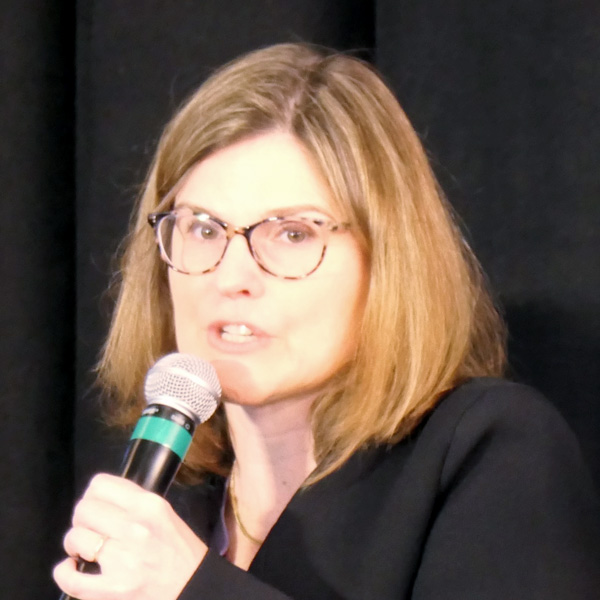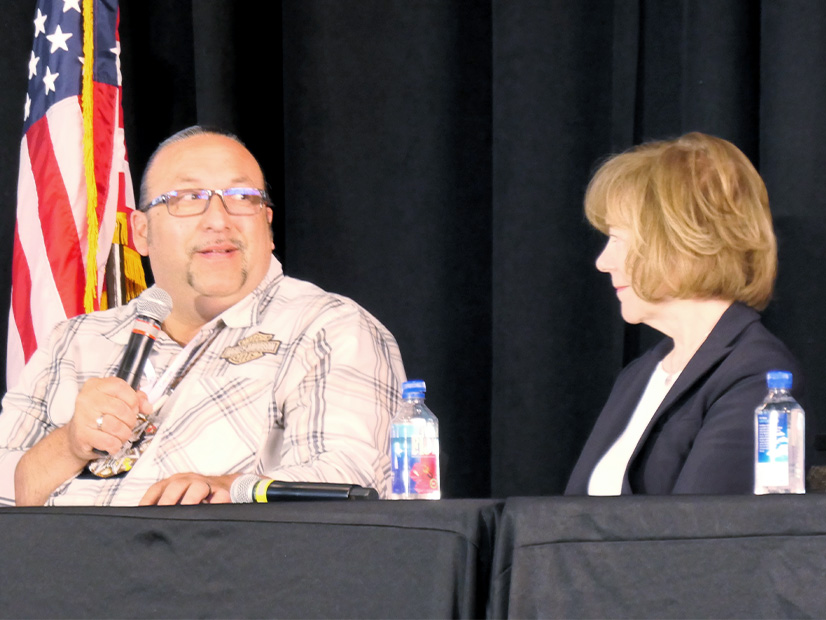MINNEAPOLIS — The 2024 Mid-America Regulatory Conference (MARC) June 9-12 showcased a tug-of-war of positivity and cynicism over meeting growing demand with a fleet that should evolve faster to meet clean energy goals.
‘Kitchen Renovations’
“You know how it feels when you’re renovating your kitchen, and you have to live there at the same time? It’s uncomfortable. … And that’s how it’s going to feel in the clean energy transition,” Smart Electric Power Alliance’s Yok Potts said in opening a panel on virtual power plants.
Much like the reward of a new kitchen after the inconvenient remodeling, the grid will emerge modernized and smarter, Potts said.
Illinois Commerce Commissioner Conrad Reddick said it’s challenging to enter a new territory of unpredictable load growth after years of expected patterns.
“The years of, ‘the grid isn’t growing so we don’t need to replace things’ are gone,” he said.
Sen. Tina Smith (D-Minn.) also said the messaging around the clean energy transition has changed in recent years.
“The old story of the energy transition is ‘we have to do this, or we’re all going to die,’” she said. Now, she said it’s “a story of opportunity” that can result in economic booms, good jobs, a cleaner environment and a more equitable supply of energy.
Smith said she will never forget during her time as Minnesota’s lieutenant governor when a teenage climate activist asked, “What are you going to do with your power?” She asked commissioners and regulatory staff to reflect on that question themselves.
The Data Center Question
Minnesota Public Utilities Commissioner Joe Sullivan said load growth from data centers could expedite the move to clean sources of energy. However, he said the rising growth carries risks of moving backward in the clean energy transition, or over-forecasting demand and then overbuilding generation that ratepayers get stuck with.
“Data centers are giving us a lot of bad news and good news,” Minnesota PUC Commissioner Hwikwon Ham said.
Xcel Energy’s Ryan Long said the rise of data centers comes at an opportune time, with Xcel switching off its remaining coal plants. He said he sees an opportunity for data centers to facilitate the “last firm clean energy” sources needed to get utilities to 100% carbon-free electricity.
But Long said utilities should craft contracts carefully so data centers pay a fair rate for energy and so utilities can “spread fixed costs among more sold kilowatt hours.”
Long said in the past, developers behind data centers were more likely to ask for discounts while insisting on 100% clean energy, whereas now they’re more willing to “ride out the rest of our energy journey with us.” He emphasized that utilities should keep commitments to existing customers and environmental goals at the forefront. He said data centers shouldn’t be subsidized by the existing customer base.
Aaron Tinjum, of the Data Center Coalition, said data centers generally are “highly efficient facilities” and his member companies’ “North Star” is clean, reliable electricity that decarbonizes the existing grid.
MISO Executive Director of Resource Adequacy Scott Wright said spot load growth from data centers is new to MISO, whose load growth has been “lackluster” for years.
“We haven’t seen anything like this on the load side in a couple decades, before MISO’s formation,” Wright said.
However, Wright said MISO’s load-serving entities cannot account for some of the growth in their forecasts because the projects are speculative. Wright said MISO likely will introduce probabilistic load forecasting to capture a plausible level of growth.
Wright said MISO has so far accumulated about 10 GW of demand from data center announcements in the footprint, with a new announcement occurring every few weeks. But he said aside from the data centers, the Midwest is entering a manufacturing renaissance.
“This is really an economic development opportunity for the Midcontinent,” Wright said. “A year from now, let’s talk about how we innovated, instead of being at the same place, talking about this tsunami of economic development at MISO’s doorstep.”
Wright said if load growth takes hold like some believe, it makes MISO’s long-range transmission planning (LRTP) even more essential. But he warned that MISO is still waiting for 50 GW of approved and unbuilt generation to emerge. Developers within MISO remain encumbered by supply chain challenges, he warned.
Sullivan said MISO’s switch from a deterministic forecast to probabilistic load forecast gives him pause. He said utilities are naturally incentivized to overbuild and he’s concerned a probabilistic approach could put “a thumb on the scale” toward construction.
Wright said its resource adequacy survey with the Organization of MISO States, due out publicly next week, is returning an uptick in demand.
“We’ve got to know how big this thing could be. We’ve got to scope it out,” Wright said. “The risk of not being prepared is bad for reliability and perhaps a huge, missed opportunity for economic growth.”
Pilot Project Effectiveness
CenterPoint Energy’s Muss Akram said it’s incumbent on utilities and regulators to share the results of pilot projects so others in the industry get a heads-up on which technologies on the cusp are practicable.
“I see the industry moving more and more in that direction, and it’s exciting,” Akram said.
“Everybody wants to pilot, right?” Heimdall Power CEO Jørgen Festervoll said, adding that regulators don’t always need a demonstration via a pilot because some technology has been in use and proven in other parts of the country for years.
Festervoll jokingly said he’s learned not to bring up what Europe is doing on its grid during his presentations. But he said the U.S. grid, which took 120 years to build, is set to see a doubling in demand soon. He said regulators and utilities must develop a willingness to deploy technologies that haven’t been in widespread use on the grid.
“There’s no way we’re going to be able to build ourselves out of this problem,” he said while pitching his company’s sensors that are mounted on power lines and use real-time conditions to flow more power.
“We’re in a phase right now where we’re not synchronizing very well,” said Iowa Utilities Board Commissioner Josh Byrnes. He said utilities are powering down old baseload plants as developers simultaneously “break ground” on data centers that will introduce new load. All this while breakthrough technology seems years away, he said. Complicating matters, the industry is struggling to attract new talent and secure supplies, Byrnes said.
“It’s a problem right now,” he summed up. “The grid is so tight. It makes me nervous. We really need to be squeezing out every electron.”
VPPs
Sparkfund founder Pier LaFarge said though the virtual power plants of today are too unsophisticated and slow to respond to influence utility planning, they will become “core” to generation and system planning in time. Virtual power plants eventually will reach gigawatt-scale with utility management, he said, and urged regulators to make participation free and give underserved customers the first opportunity to join.
“There’s been decades of antagonism between [distributed energy resources] and the utility,” LaFarge said. But he added that tension will dissipate as utilities “take DERs for what they should be” and develop tools and programs.
Midcontinent Considerations for Energy Storage
Clean Grid Alliance Executive Director Beth Soholt said several gigawatts of storage are lined up in MISO’s interconnection queue at a time when the RTO needs to overhaul its studies. She said MISO currently rigidly assumes storage charges at shoulder times and discharges on peak and imposes limits on charging that are in place for the life of the storage asset. Soholt said a “cookie-cutter” approach to every project is obscuring some of the benefits that storage can provide and returning expensive network upgrades.
“It’s a bit of a square peg in a round hole. … We’re focused on getting the model right,” Soholt said. “I just feel we need more storage online so utilities figure out exactly how they want to use it. We need to kick the tires and show exactly what it can do.”
Illinois Commerce Commissioner Stacey Paradis predicted there will be “sticky issues” around RTOs’ interconnection of storage that will need to be figured out in the next few years. She said even though the industry is “crawling toward” storage penetration at present, it will become a game-changer.
Energy Dome’s Eric Watson said any storage company would be happy to turn over extensive data to show they are the “technology of choice” and secure a place in utilities’ integrated resource plans.
Watson said his company uses modular domes to house turbines and compressors to store energy in the form of liquid CO2 under pressure. He said the domes use “off-the-shelf” components that don’t need special design.
“We’re effectively making large fire extinguishers,” Waston explained of the technology’s closed-loop, zero-emissions process.
Watson said the first U.S.-based dome will be at Alliant Energy’s retiring Columbia Energy Center in Wisconsin and will use the plant’s existing interconnection rights with MISO to come online sometime in 2026. He said he hopes the facility can return “good data” to show that Energy Dome technology is viable elsewhere.
Order 1920, Interregional Tx Planning
MARC secured a FERC commissioner to speak on last month’s Order 1920.
Commissioner Allison Clements said the order “is in a lot of ways modeled after what MISO is already doing” and said regulators of MISO states should feel good about that.
FERC even contemplated “not messing up” the planning MISO already engages in when drafting the rule, she said.
Clements said the rule requires players in the planning realm to consider needs years down the road and consider both intensive and lower-cost solutions. She said there’s an opening now to reassess what’s no longer working on the grid and deploy “emerging technologies that are in fact as old as the Walkman.” She said it’s time to innovate in the electricity sector, which historically hasn’t been a hot spot for technological advancements.
“If we can get past that color of molecule or that source of electron, if we all want to be grownups sitting around the table, there’s a lot of progress to be made,” she said.
MISO’s Jennifer Curran said MISO already is largely conducting the long-term, scenario-based transmission planning that Order 1920 prescribes.
However, a panelist from ITC said the same can’t be said of the RTO’s interregional transmission planning.
“There’s interregional coordination going on. Not so much planning,” ITC’s Krista Tanner said. “The current process isn’t producing projects.”
Tanner said planning between the RTOs only seems to work when they step outside their existing processes, like MISO and SPP’s Joint Targeted Interconnection Queue (JTIQ) portfolio of transmission projects. Tanner said MISO and PJM’s recently announced transfer capability study seems promising also because it’s a departure from the RTOs’ usual coordinated system plan studies. (See MISO, PJM Agree to Perform New Type of Joint Transmission Study.)
“Thinking out of the box is key,” Curran said of her experience working on the JTIQ with SPP.
Curran said a study dedicated to MISO and PJM’s seams is timely, with NERC and FERC focusing on transfers between grid operators. PJM’s Sami Abdulsalam said the RTOs have begun scoping the study and are focusing on avoiding complex, greenfield development. Abdulsalam also said PJM “isn’t quite there yet” on undertaking a JTIQ-like study with MISO.
Curran said MISO’s job is easier when the RTOs’ state regulatory committees come forward and articulate which issues they want MISO and its neighbors to address. The Organization of MISO States and the Organization of PJM States wrote a letter to the RTOs at the beginning of the year to call for more extensive joint planning.
Tanner asked RTO planners, regulators and utilities to contrast the costs of backbone, interregional projects with the more destructive outcomes of extreme weather events without the transmission. She said four days like with Winter Storm Uri in early 2021 can inflict as much cost in damages and fuel as the whole of MISO’s first, $10 billion LRTP portfolio.
Cooperation in Permitting
Energy consultant Charles Sutton said landowner fatigue with permitting has grown recently and will continue to increase as MISO’s LRTP projects enter the construction phase.
He said developers can blunt the negativity by awarding construction to local companies to show they support the local economy. Sutton added that developers should anticipate totally different reactions in different communities and that developers should be flexible and not rely on a single playbook to convince communities.
Robert Larsen, president of the Lower Sioux Indian Community, urged regulators to open honest communication at the very beginning stages of development “before things are too late, before things get disturbed.” He said groups should consult with tribal nations during scoping steps, not when they’re ready to begin construction.
“We’ve always said that progress is great, but we cannot have progress that destroys,” Larsen said. He urged utilities, developers and regulators to “do their homework” and research who historically lived in the areas they’ve designated for projects.
Larsen said for instance, wind developers have sited projects near Buffalo Ridge in Southwestern Minnesota, a high point in the geography where the native community comes to pray and fast. The “blinking red lights” of the turbines are a distraction, he said.
But Larsen said he was taken aback and touched when the Minnesota PUC last year voluntarily asked to be included in a state law that requires consultation with tribal nations.
Larsen urged young people in the crowd to remember their relationship with the land. He applauded Minnesota’s 2040 clean energy deadline and called for a restoration of land after “we’ve stripped it, mined it, polluted it.”
“We want to keep everything clean and useful,” he said.
Sen. Smith said utilities and regulators must regard tribal nations as sovereign entities, not special interest groups, with authority that is “inherent instead of bequeathed.”
NextGen Highways’ Randy Satterfield, whose company attempts to bundle infrastructure rights of way along roadways, said initiatives such as “co-locating infrastructure where there’s already infrastructure” is common sense.
Satterfield said Wisconsin for 20 years has allowed stackable rights of way for transmission in highway corridors, but many states ban combination permitting along interstates. Last month, Minnesota Gov. Tim Walz (D) ended the Department of Transportation’s ban on co-location of transmission along highways when he signed an omnibus transportation bill. NextGen Highways led the push for the language in the legislation.
Unions Make Appearance
In a MARC first, the annual conference featured a panel devoted to union labor.
ICC Commissioner Michael Carrigan, himself a member of the International Brotherhood of Electrical Workers Local 146, said it’s going to be an undertaking to recruit a workforce that can grow to meet demand.
Kurt Zimmerman, of the IBEW Local 160, said utilities must stay competitive when negotiating contracts, enough to ensure laborers have good careers. He asked commissioners reviewing projects to make sure the labor is from an indentured program to ensure a “solid, safe, reliable” workforce.
“Who builds projects is not something in the last 20 years that people have necessarily cared about,” said Jason George, of the International Union of Operating Engineers Local 49. “As a commissioner or developer, you should really care who’s building your projects.”
George said high schoolers these days don’t select their career field from a table at a career fair and want to know their work will be meaningful. He said aspiring apprentices now can take high school courses introducing them to engineering and take hands-on trade tours. George also said he’s on the lookout to recruit kids for training who don’t have experience with machinery, as well as the kids who grew up on a farm.
“People come in and change the course of their whole generational history with one job and a union card. It’s life-changing,” George said.
Richard Kolodziejski, of the North Central States Regional Council of Carpenters, said it’s important to seek out union labor so untrained people aren’t building the energy infrastructure of the future.
Kolodziejski said the construction trades culture needs to change to be more welcoming to women and people of color. He also said there should be more attention on the mental health of construction tradespeople, who experience some of the highest rates of suicide by vocation.



